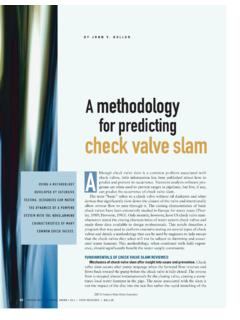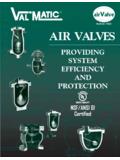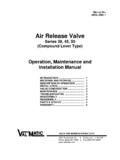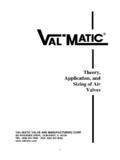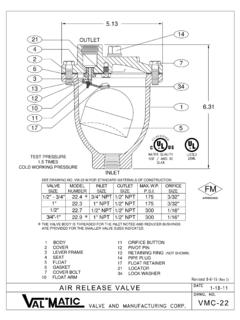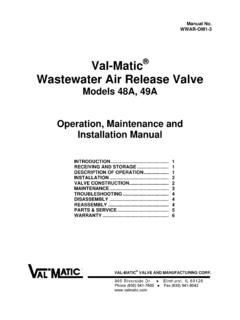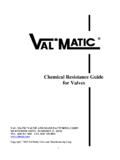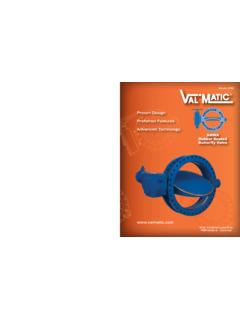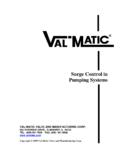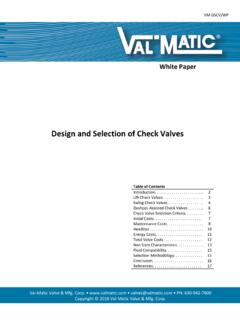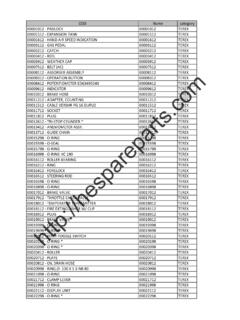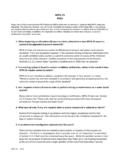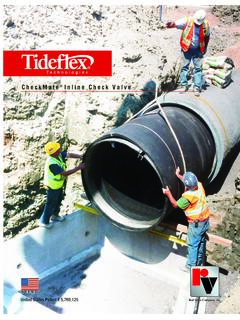Transcription of Surge Control in Pumping Systems - Val Matic Valve ...
1 VM SCPS/WP. White Paper Surge Control in Pumping Systems Table of Contents Introduction.. 2. Cause and Effects.. 2. Surge Background.. 3. Pumps.. 4. Vertical Pumps and Well Service Air valves .. 4. check valves .. 6. Fast Closing check valves .. 6. Pump Control Systems .. 8. Pump Control Valve Operation.. 10. Surge Relief Equipment.. 11. Stand Pipes and Surge Tanks.. 11. Surge Relief valves .. 12. Surge Suppression Air valves .. 13. Vacuum Breaker valves .. 13. Summary.. 14. References.. 15. Val Matic Valve & Mfg. Corp. PH: 630 941 7600. Copyright 2018 Val Matic Valve & Mfg. Corp. Surge Contol in Pumping Systems INTRODUCTION. Water pipelines and distribution Systems are subjected to surges almost daily, which over time can cause damage to equipment and possible contamination.
2 Surges are caused by sudden changes in fluid velocity and can be as minor as a few psi to five times the static pressure. The causes and effects of these surges in Pumping Systems will be discussed along with equipment designed to prevent and dissipate surges. Only with the knowledge of all of the associated valves and Surge equipment can a successful Pumping system with acceptable Surge levels be designed. Reference will be made to typical installations and examples so that an understanding of the applicable constraints can be gained. Figure 1 illustrates a typical water Pumping /distribution system where two parallel pumps draw water from a wet well then pump the water through check and butterfly valves into a pump header and distribution system.
3 A Surge tank and Surge relief Valve are shown as possible equipment on the pump header to prevent and relieve surges, respectively. FIGURE 1. Typical Pumping /Distribution System CAUSES AND EFFECTS. Surges are caused by sudden changes in flow velocity that result from common causes such as rapid Valve closure, pump starts and stops, and improper filling practices. Pipelines often see their first Surge during filling when the air being expelled from a pipeline rapidly escapes through a manual vent or a throttled Valve followed by the water. Being many times denser than air, water follows the air to the 2. Surge Contol in Pumping Systems outlet at a high velocity but is then rapidly restricted by the outlet causing a Surge .
4 It is imperative that the system fill flow rate be carefully controlled to less than 2 ft/sec fluid velocity and the air vented through properly sized automatic Air valves . Similarly, line valves must be closed and opened slowly to prevent rapid changes in flow velocity. The operation of pumps and sudden stoppage of pumps due to power failures probably have the most frequent impact on the system and the greatest potential to cause significant and frequent surges. If the Pumping system is not controlled or protected, contamination and damage to equipment and the pipeline itself can be serious. The effects of surges can be as minor as loosening of pipe joints to as severe as damage to pumps, valves , and concrete structures.
5 Damaged pipe joints and vacuum conditions can also cause contamination to the system from ground water and backflow situations. Uncontrolled surges can be catastrophic as well. Line breaks can cause flooding and line shifting can cause damage to supports and concrete piers and vaults. Losses can be in the millions of dollars so it is essential that surges be understood and controlled with the proper equipment. Surge BACKGROUND. Some of the basic equations of Surge theory will be presented so that an understanding of Surge Control equipment can be gained. First, the Surge pressure (H) resulting from an instantaneous flow stoppage is directly proportional to the change in velocity and can be calculated as follows: H = av/g where: H = Surge pressure, ft water column a = speed of pressure wave, ft/sec v = change in flow velocity, ft/sec g = gravity, ft/sec2.
6 The speed of the pressure wave (a) varies with the fluid, pipe size, and pipe material. For a medium sized steel line, it has a value of about 3500 ft/sec. For PVC pipes, the speed will be significantly less. For a 12 in. steel line with water flowing at 6 ft/sec, the magnitude of a Surge from an instantaneous flow stoppage is: H = (3500 ft/sec)(6 ft/sec) / ( ft/sec2). H = 652 ft water column This Surge pressure of 652 feet (283 psig) is additive to the static line pressure; therefore, the resultant pressure will likely exceed the pressure rating of the system. Further, the Surge pressure will be maintained for several seconds as the wave reflects from one end of the piping system to the other end causing over pressurization of valves , pipe seals, and fittings.
7 Then after a reflection, the pressure wave may cause a negative pressure and vacuum pockets for several seconds allowing contaminated ground water to be drawn into the system through seals or connections. Even higher velocities than the Pumping velocity are attainable in long piping Systems , especially when there are significant changes in grade. If the pumps are suddenly stopped due to a power failure, the kinetic energy of the water combined with the low inertia of the pump may cause a separation in the water column at the pump or at a highpoint in the pipeline. When the columns of water return via the static head of the line, the reverse velocity can exceed the normal velocity.
8 The resultant Surge pressure can be even higher than the 652 feet calculated above. Transient analysis computer programs are 3. Surge Contol in Pumping Systems normally employed to predict column separation and the actual return velocities and surges. Transient programs can also model methods and equipment employed to Control and prevent column separation such as the use of a Surge Tank, Vacuum Breaker, or Surge Suppression Air Valve . Thus far, the changes in velocity have been described as sudden. But how sudden must changes in velocity be to cause surges? If the velocity change is made within the time period it takes for the pressure wave to travel the length of the pipeline and return, then the change in velocity can be considered instantaneous and the equation for Surge pressure (H) given earlier applies.
9 This time period, often called the critical period , can be calculated by the equation: t = 2L/a where: t = critical period, sec L = length of the pipe, ft a = speed of the pressure wave, ft/sec For the earlier example, (12 in. line), the critical period would be as follows for a 4 mile long steel pipeline: t = 2 (21,120 ft) / (3500 ft/sec). t = 12 sec Therefore, to cause surges, a pump does not need to stop quickly nor does the Valve need to close instantaneously (or even suddenly). A normal flow stoppage of 5 or 10 seconds may cause the maximum Surge (H) in long Pumping Systems . It follows that Surge Control strategies should be employed to slow down changes in velocity on all long pipelines.
10 PUMPS. Referring again to Figure 1, a key to controlling surges in Pumping Systems is to Control the rate of increase and decrease of the flow velocity into the system. Pumps should be sized for the expected flow requirements. Oversized pumps can create havoc in certain Pumping Systems . Some pump station designs employ multiple pumps to match varying demand so that when one of the multiple pumps is started or stopped, it has a minor impact on the overall pipeline velocity. These Systems Control supply and can prevent surges during normal pump operation. Another option is to use specialized motor Control equipment ( variable frequency drives or soft start controls) to slow down the start and stop of a pump over 2 to 30 seconds.

